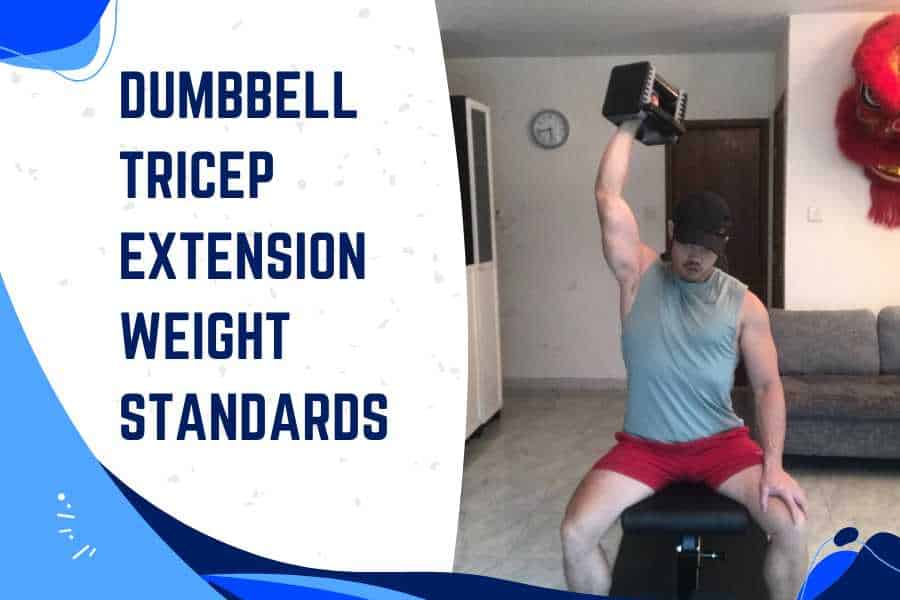To build a stronger dumbbell tricep extension, you need to be lifting a suitable amount of weight. But strength standards vary between individuals. This post reveals weight standards for the dumbbell tricep extension for you to benchmark your performance.
A respectable dumbbell tricep extension for the average male beginner is around 10% of body weight for a single repetition. Intermediates and advanced lifters should be able to lift around 30% and 45% (respectively) for 1 rep.
The weight standards in this post will help you determine what is a respectable weight to be lifting based on your gender, body weight, and training experience.
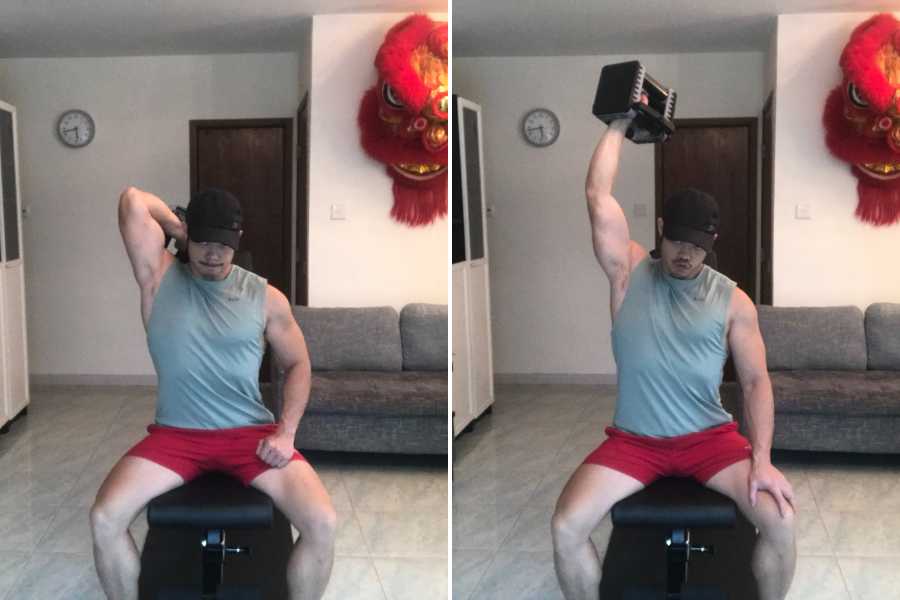
- How To Use These Weight Standards
- Beginner Dumbbell Tricep Extension Weight Standards
- Intermediate Dumbbell Tricep Extension Weight Standards
- Advanced Dumbbell Tricep Extension Weight Standards
- How Good Is Your Dumbbell Tricep Extension Vs Others?
- 5 Reasons Why Your Dumbbell Tricep Extension Strength Is Below Average
- Other Weight Standards For Dumbbell Tricep Extension Muscles
- Conclusion
How To Use These Weight Standards
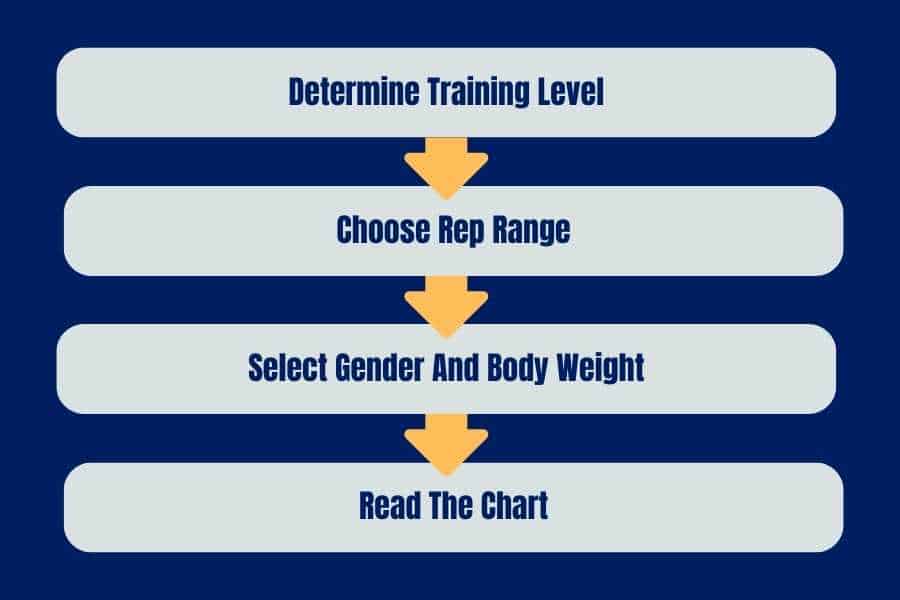
1) Determining your training level:
- Beginners have practiced the tricep extension for 1-12 months.
- Intermediates have practiced the tricep extension for 12-36 months.
- Advanced lifters have practiced the tricep extension for 4 years or more.
2) Choosing your rep range:
The weight standards are given for:
- 1-rep max (1RM)- this is the maximum amount of weight you can lift for a single repetition. It’s often used as a strength standard.
- 6-10 working reps- this is generally considered to be the ideal rep range for building muscle.
3) Selecting your gender and body weight:
- Average dumbbell tricep extension weight standards are revealed for common body weights.
- Male tricep extension standards are given.
- Females can use a 60% conversion (multiply the weight standard by 0.60).
4) Reading the charts:
- Weight standards are given as lbs on the top and kg on the bottom.
- If you’re doing tricep extensions at or above the weight standard for your given training level, body weight, and gender, then you are lifting a respectable amount of weight.
Beginner Dumbbell Tricep Extension Weight Standards
Here’s how much weight you should be lifting on the dumbbell tricep extension as a beginner:
| Bodyweight | 1-rep max | 6-rep max | 7-rep max | 8-rep max | 9-rep max | 10-rep max |
|---|---|---|---|---|---|---|
| 120lb 54kg | 6lb 3kg | 5lb 2kg | 5lb 2kg | 5lb 2kg | 5lb 2kg | 4lb 2kg |
| 150lb 68kg | 11lb 5kg | 9lb 4kg | 9lb 4kg | 9lb 4kg | 9lb 4kg | 8lb 4kg |
| 200lb 91kg | 19lb 9kg | 16lb 7kg | 16b 7kg | 15lb 7kg | 15lb 10kg | 14lb 6kg |
| 250lb 113kg | 27lb 12kg | 23lb 10kg | 22lb 10kg | 22lb 10kg | 21lb 7kg | 20lb 9kg |
| 300lb 136kg | 35lb 16kg | 29lb 13kg | 29lb 13kg | 28lb 13kg | 27lb 12kg | 26lb 12kg |
Generally speaking, beginners should be able to do tricep extensions with dumbbells that weigh 5 to 10% of their body weight for a single repetition (1-rep max).
Intermediate Dumbbell Tricep Extension Weight Standards
Here’s how much weight you should be lifting on the dumbbell tricep extension as an intermediate lifter:
| Bodyweight | 1-rep max | 6-rep max | 7-rep max | 8-rep max | 9-rep max | 10-rep max |
|---|---|---|---|---|---|---|
| 120lb 54kg | 36lb 16kg | 30lb 14kg | 30lb 13kg | 29lb 13kg | 28lb 13kg | 26lb 12kg |
| 150lb 68kg | 47lb 21kg | 39lb 18kg | 39lb 17kg | 38lb 17kg | 37lb 17kg | 34lb 16kg |
| 200lb 91kg | 63lb 29kg | 53lb 24kg | 52lb 23kg | 50lb 23kg | 49lb 22kg | 46lb 21kg |
| 250lb 113kg | 78lb 35kg | 66lb 30kg | 64lb 29kg | 62lb 28kg | 61lb 28kg | 57lb 26kg |
| 300lb 136kg | 90lb 41kg | 76lb 34kg | 74lb 33kg | 72lb 33kg | 70lb 32kg | 66lb 30kg |
Generally speaking, intermediates should be able to do tricep extensions with dumbbells that weigh 30% of their body weight for a single repetition.
Advanced Dumbbell Tricep Extension Weight Standards
Here’s how much weight you should be lifting on the dumbbell tricep extension as an advanced lifter:
| Bodyweight | 1-rep max | 6-rep max | 7-rep max | 8-rep max | 9-rep max | 10-rep max |
|---|---|---|---|---|---|---|
| 120lb 54kg | 61lb 28kg | 51lb 23kg | 50lb 23kg | 49lb 22kg | 48lb 22kg | 45lb 20kg |
| 150lb 68kg | 75lb 34kg | 63lb 29kg | 62lb 28kg | 60lb 27kg | 59lb 27kg | 55lb 25kg |
| 200lb 91kg | 96lb 44kg | 81lb 37kg | 79lb 36kg | 77lb 35kg | 75lb 34kg | 70lb 32kg |
| 250lb 113kg | 113lb 51kg | 95lb 43kg | 93lb 42kg | 90lb 41kg | 88lb 40kg | 82lb 37kg |
| 300lb 136kg | 128lb 58kg | 108lb 49kg | 105lb 48kg | 102lb 46kg | 100lb 45kg | 93lb 42kg |
Generally speaking, an advanced lifter should be able to do tricep extensions with dumbbells that weigh 40 to 50% of their body weight for a single repetition.
How Good Is Your Dumbbell Tricep Extension Vs Others?
Here’s the average percentage of people who can do tricep extensions at a fraction of their own body weight using dumbbells:
| Dumbbell Tricep Extension 1RM Weight (as a fraction of body weight) | % Of People Who Can Do It |
|---|---|
| 0.05x | 99% |
| 0.10x | 95% |
| 0.15x | 87% |
| 0.20x | 77% |
| 0.25x | 66% |
| 0.30x | 54% |
| 0.35x | 42% |
| 0.40x | 32% |
| 0.45x | 24% |
| 0.50x | 17% |
| 0.55x | 12% |
| 0.60x | 8% |
| 0.65x | 6% |
| 0.70x | 4% |
| 0.75x | 2% |
| 0.80x | 2% |
| 0.85x | 1% |
| 0.90x | 0.6% |
| 0.95x | 0.4% |
| 1.00x | 0.2% |
This allows you to compare your standards with others and determine how good your numbers are.
To calculate your tricep extension as a fraction of your own body weight, simply divide the weight of your 1RM by your body weight.
For example: if you weigh 180lbs and your tricep extension 1RM is 50lbs, then you’re lifting 0.28x your body weight (50lbs ÷ 180lbs).
The above chart indicates:
- 75% of people can do tricep extensions using dumbbells 0.20x their body weight for 1 rep. This represents the lower quartile of lifters and is a respectable weight for beginners to achieve.
- 50% of people can do tricep extensions using dumbbells 0.30x their body weight for 1 rep. This represents the median quartile of lifters and is a respectable weight for intermediates to achieve. It’s also a realistic target for beginners to aim towards with enough training.
- 25% of people can do tricep extensions using dumbbells 0.45x their body weight for 1 rep. This represents the upper quartile of lifters and is a respectable weight for advanced lifters. It’s also a realistic target for intermediates to aim towards with enough training.
5 Reasons Why Your Dumbbell Tricep Extension Strength Is Below Average
According to a poll I conducted, the main target muscle for the dumbbell arm extension- the triceps- are some of the easiest muscles to build. However, you may still be struggling with this exercise.
Here are 5 common reasons why you may find it difficult to perform the tricep extension using dumbbells, and why your weight standards are below average.
I’ve also shared solutions for each problem.
These solutions can help to improve your tricep extension.
1) Flared elbows.
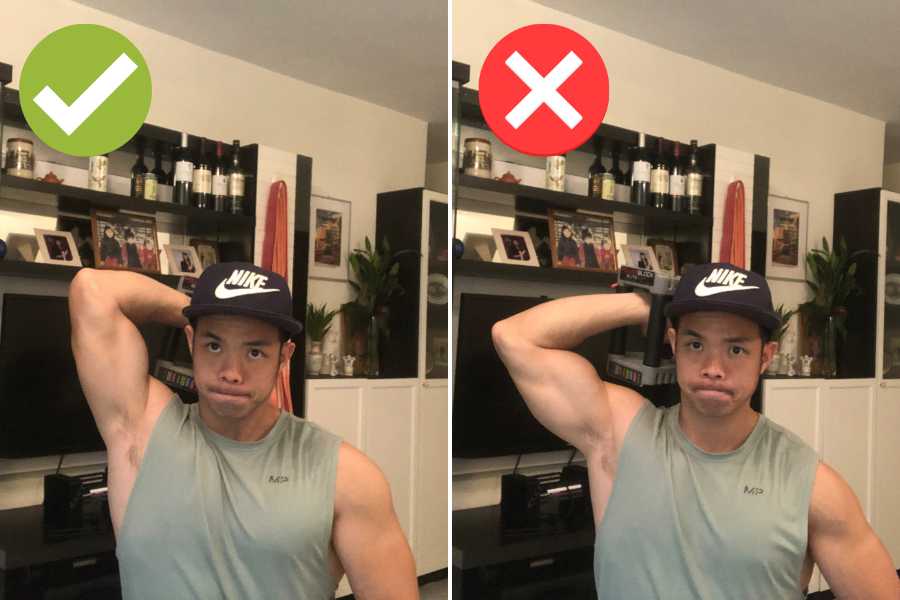
Flaring your elbows outward is not recommended.
It puts your shoulders in a state of excessive internal rotation (rotating your upper arm in and towards the chest).
This commonly happens because:
- People do not know they are doing it.
- The dumbbell weight is too heavy.
Elbow flare and internal rotation make the dumbbell tricep extension more difficult for 2 reasons:
- Increases shoulder joint stress (can sometimes be painful).
- Decreases triceps activation.
As a result, your tricep extension strength will be reduced.
Solution:
The elbows should never be flared outwards at any time during the movement.
I prevent elbow flare from happening by actively tucking my elbows towards the torso midline and keeping my biceps within 5 inches away from my ears.
Another tip is to simply reduce to a correct lifting weight (a load that you can easily handle). This allows you to perform the exercise with good form and focus on not letting your elbows flare outward.
2) Underdeveloped arm muscles.
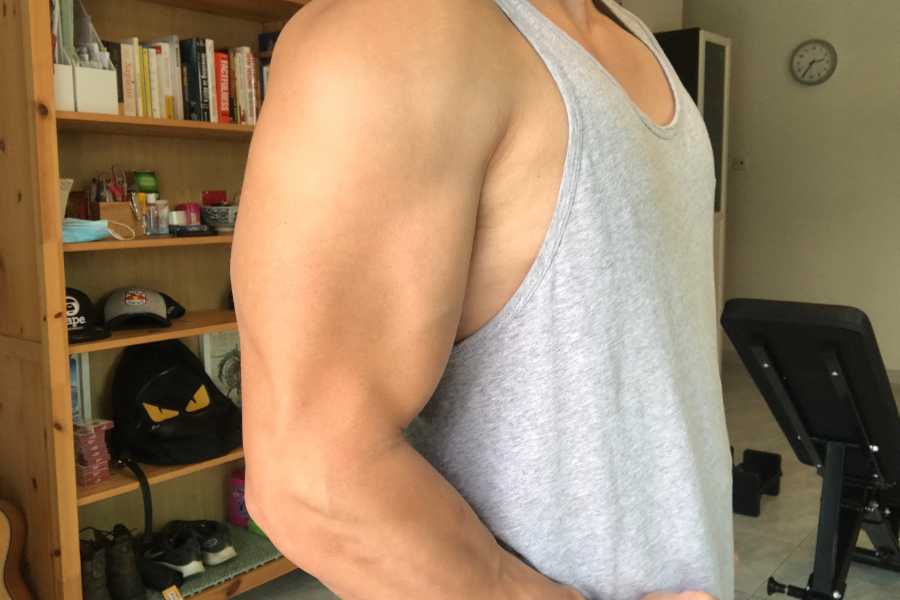
The tricep extension is an isolation-type exercise mainly targeting the triceps.
But the triceps comprise 3 smaller regions including the; long, medial, and lateral heads. Additionally, the biceps and deltoids also serve to stabilize the movement.
Thus, all arm muscles should be worked to gain the maximum strength benefits.
If any of these muscles are weak, then your overhead extension strength will be lower than normal.
Solution:
A common mistake made by beginners trying to build bigger arms is to think that bicep curls and tricep extensions alone are enough.
Whilst these two movements are great and can be sufficient to promote arm growth, you should ideally include a variety of different movements to hit each muscle region for maximal growth.
A good arm workout routine doesn’t require much more than 5-10 different exercises. But they should be carefully selected and you should use the correct dumbbell weight.
I recommend including compound tricep exercises like the bench press and dip, alongside the tricep extension, to grow your triceps fast.
3) Not going on a bulk

Building bigger and stronger triceps isn’t just about training. You also need to combine this with a good nutrition plan to fuel muscle growth and repair.
In fact, one of the most common reasons why beginners fail to build muscle and strength is simply because they’re following a poor diet plan.
If you aren’t eating surplus calories and protein (also called bulking), strength gains will plateau very quickly.
Solution:
Determine your daily maintenance calories using a TDEE calculator and add 5-15%. This is how many calories you should be eating every day to fuel muscle growth (hypertrophy).
Additionally, aim to consume at least 1g of protein per lb of body weight. This provides the raw materials for tricep growth.
Bulking can be hard for beginners.
The easiest way without micromanaging your nutrition is to incrementally increase calorie and protein intake alongside your training, and watch out for the main signs of muscle growth.
4) You are doing the tricep extension standing up.
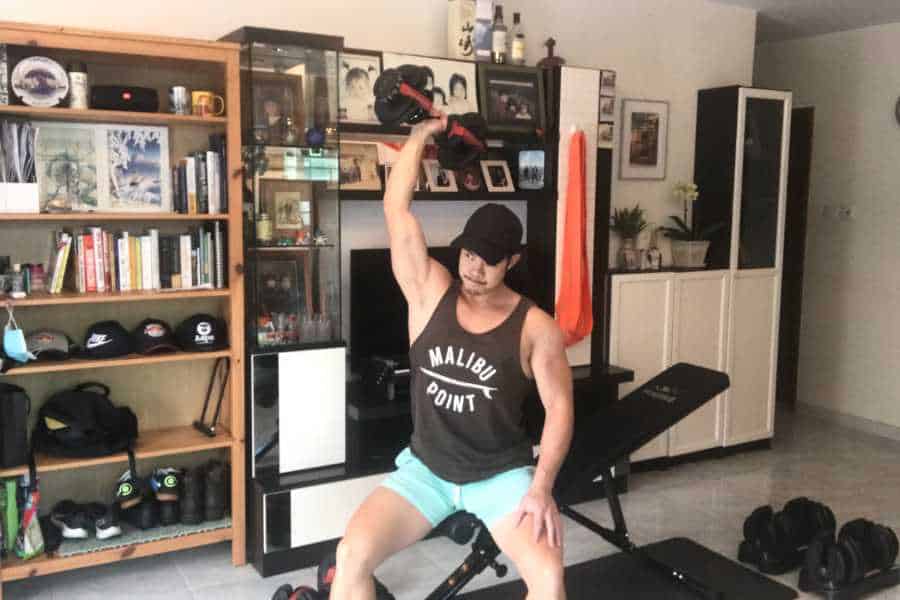
Choosing to stand or sit can affect how much weight you can lift on the dumbbell tricep extension.
This has been shown in a 2013 study that demonstrated more weight could be lifted in the tricep extension when standing up compared to sitting down.
The seated variation provides a stable base for you to lift from and reduces the requirement of having a strong core for stabilization.
Therefore a weak overhead extension could be because you’re doing it standing up rather than sitting down.
Solution:
Switch from a standing to a seated dumbbell tricep extension. This can be easily done at the gym.
If you’re training at home, then you can use a stable chair.
But for the safest option, I recommend buying a mid-range weight bench. I use the Flybird FB149. It provides great value for money and can also be folded for convenient storage.
5) Inadequate training volume.
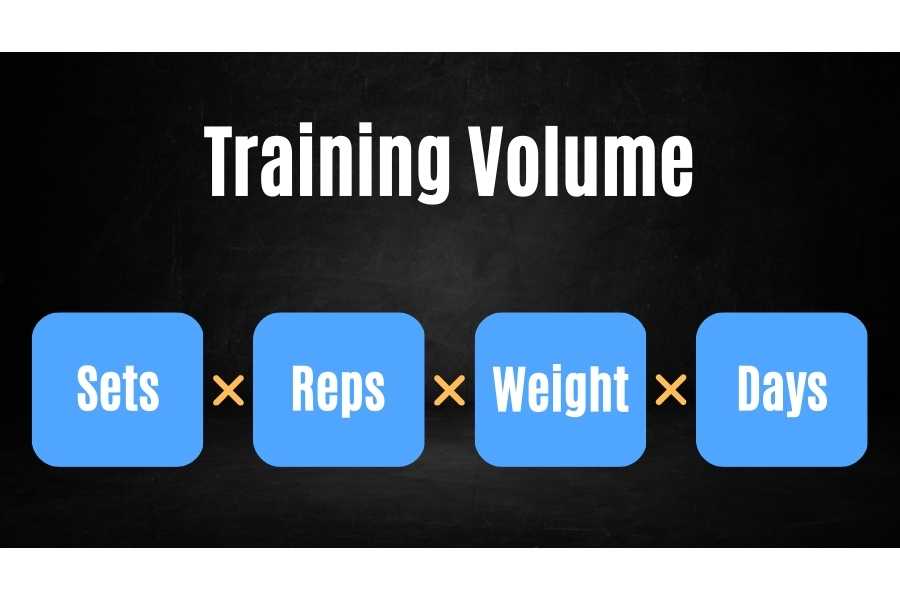
Hitting a sufficient weekly training volume is important for building any muscle, including the triceps.
Volume describes the total number of sets, reps, weight, and workouts you perform each week.
Speaking from experience, it’s very easy for a beginner to think they’re doing more work than they actually are.
And when this happens, you may find your dumbbell tricep extension below the average strength standards for your given bodyweight, gender, and experience.
Solution:
Aim to complete 10-20 total sets for triceps per week. Beginners can stay on the lower end of this spectrum.
Work in a moderate-high rep range of 8-15 reps per set (working in higher rep ranges for arms is best).
Lift a weight that challenges you for each set.
And try and complete 2-3 workouts per week with at least 24 hours of rest in between workouts.
You can check out my 3-day home routine for skinny guys for a complete program to build full-body muscle (including the arms).
Other Weight Standards For Dumbbell Tricep Extension Muscles
Dumbbell extensions are an isolation-type movement that primarily works the triceps at the back of your arm. Here are weight standards for other exercises that hit similar muscle groups:
- Dips– a compound pushing exercise that’s great for loading your triceps with a heavy weight.
- Bench press with dumbbells– horizontal compound pushing exercise that mainly engages the chest but also your triceps.
- Shoulder press with dumbbells– vertical compound pushing exercise that primarily works the shoulders but also your triceps.
- Bicep curls– isolation-type movement that works the biceps at the front of your arms.
- Pull-ups– vertical compound pulling exercise that mainly works the back and biceps.
- Dumbbell rows– horizontal compound pulling exercise that primarily works your back but also your biceps.
Conclusion
My dumbbell tricep extension weight standards help you to determine whether or not you are lifting a respectable amount of weight for your capabilities.
Beginners should be able to do 1 rep using around 10% of their body weight. Intermediates should be able to lift approximately 30% of their body weight, and advanced lifters approximately 45%.
If you’re lifting at or exceeding these strength standards, then you’re doing a good and respectable job.
I’ve also shared common problems and solutions to a tricep extension strength that is below average.
You may also be interested in the downloadable Kalibre Blueprint PDF which details exactly how I gained 40lbs of lean muscle (it’s 100% free!). It details the exact exercises and nutrition (with printables) I used to go from skinny to ripped!

